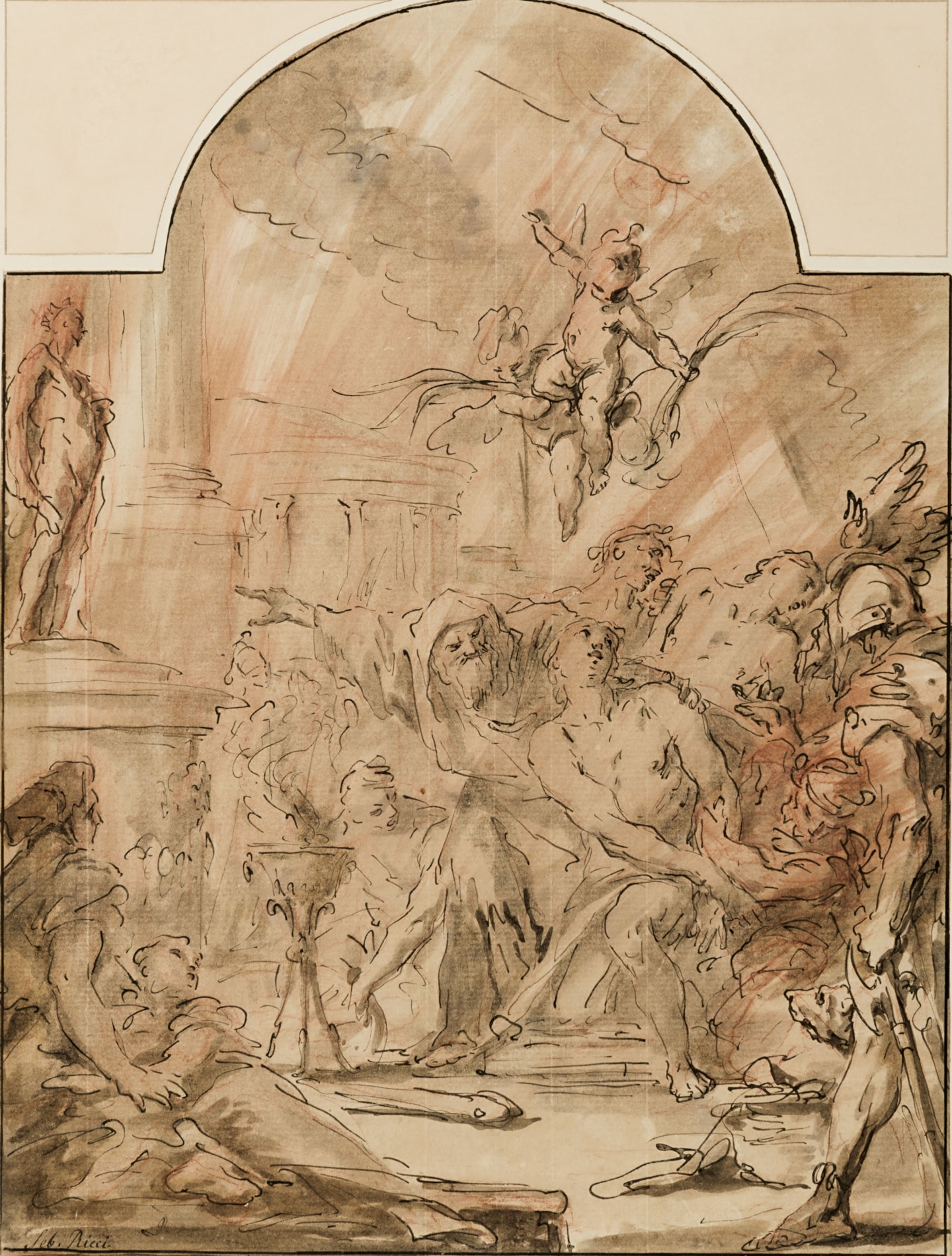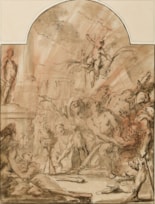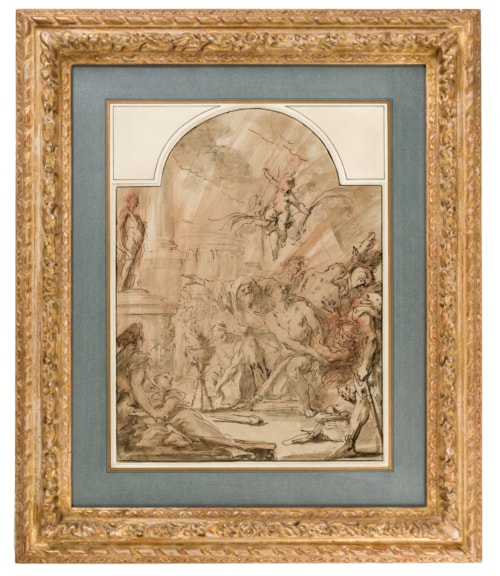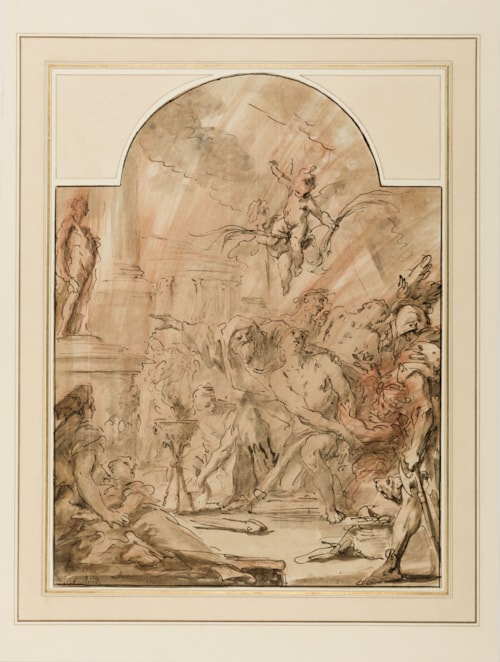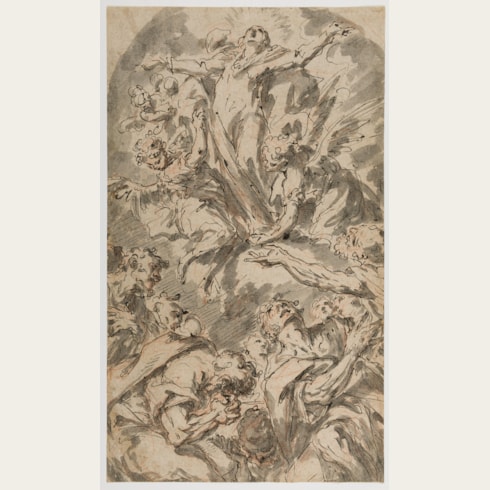Gaspare DIZIANI
(Belluno 1689 - Venice 1767)
The Persecution of Saints Felix and Fortunatus
Pen and brown ink, with brown and grey wash, over a red chalk underdrawing, with framing lines in pen and brown ink.
Laid down on a backing sheet.
Inscribed Seb. Ricci. at the lower left.
376 x 284 mm. (14 3/4 x 11 1/8 in.) at greatest dimensions.
Laid down on a backing sheet.
Inscribed Seb. Ricci. at the lower left.
376 x 284 mm. (14 3/4 x 11 1/8 in.) at greatest dimensions.
As James Byam Shaw has aptly noted, ‘In his most characteristic drawings Diziani is something of a Mannerist: in an extravagantly free style, the actions or gestures of the figures are often violent, the pen contours ragged, the wash dashed on in a few seconds with a watery brush.’ The present sheet is a preparatory study, with many differences, for Gaspare Diziani’s painting of The Torture of Saints Felix and Fortunatus in the chapel dedicated to the two saints in the cathedral of Chioggia, a town at the southern entrance to the Venetian lagoon. The painting, which can be dated to c.1735, has been described by the scholar Rodolfo Pallucchini as ‘among the most forthright and colourful works that Diziani ever painted, set with a theatrical violence…and executed with a succession of juicy and effervescent brushstrokes.’ The painting was part of a cycle of six scenes from the lives of Saints Felix and Fortunatus commissioned in the 1730s from Diziani, Giambettino Cignaroli, Nicolò Bambini, Francesco Migliori and other artists. The patron saints of Chioggia, Felix and Fortunatus were Christian brothers from Vicenza who were martyred in Aquileia in 296, during the persecutions of the reign of the Roman Emperor Diocletian. Their relics were enshrined in Vicenza in the late 4th century, but those of Fortunatus were translated to the cathedral of Chioggia in 1080.
Two further preparatory drawings by Diziani for the large altarpiece in Chioggia are known. One appeared at auction in New York in 2008, while another, closer to the final composition, is today in the Nationalmuseum in Stockholm. All three drawings have arched tops and are of similar dimensions. Taken together, they provide a fascinating insight into the development of the composition of the painting. Drawn with considerable energy and dynamism, the present sheet includes most of the elements of the final composition – the seated mother and child in the foreground, the soldiers with the bound saints, one seated and one standing, as well as the priest gesturing towards the pagan idol and the putti above bearing the palms of martyrdom - but the poses and final positions of the individual figures have yet to be determined.
The extensive underdrawing in red chalk in the present sheet, as well as the loosely washed background, are particular characteristics of Diziani’s draughtsmanship. As Catherine Whistler has noted of a similar drawing by the artist, ‘Diziani…drew with great flair, rapidly layering ink and washes over a red chalk scribbled sketch. Like [Francesco] Fontebasso, he learned much from the verve and graphic energy of his teacher Sebastiano Ricci. The animated use of red chalk, which enrichens and deepens the tonal range of the drawing, was a long-standing element in Venetian drawing practice and was especially favoured by artists of Ricci’s generation.’
Among stylistically comparable drawings by Diziani of about the same date is a Martyrdom of Saint Andrew in the Metropolitan Museum of Art in New York.
Two further preparatory drawings by Diziani for the large altarpiece in Chioggia are known. One appeared at auction in New York in 2008, while another, closer to the final composition, is today in the Nationalmuseum in Stockholm. All three drawings have arched tops and are of similar dimensions. Taken together, they provide a fascinating insight into the development of the composition of the painting. Drawn with considerable energy and dynamism, the present sheet includes most of the elements of the final composition – the seated mother and child in the foreground, the soldiers with the bound saints, one seated and one standing, as well as the priest gesturing towards the pagan idol and the putti above bearing the palms of martyrdom - but the poses and final positions of the individual figures have yet to be determined.
The extensive underdrawing in red chalk in the present sheet, as well as the loosely washed background, are particular characteristics of Diziani’s draughtsmanship. As Catherine Whistler has noted of a similar drawing by the artist, ‘Diziani…drew with great flair, rapidly layering ink and washes over a red chalk scribbled sketch. Like [Francesco] Fontebasso, he learned much from the verve and graphic energy of his teacher Sebastiano Ricci. The animated use of red chalk, which enrichens and deepens the tonal range of the drawing, was a long-standing element in Venetian drawing practice and was especially favoured by artists of Ricci’s generation.’
Among stylistically comparable drawings by Diziani of about the same date is a Martyrdom of Saint Andrew in the Metropolitan Museum of Art in New York.
Born in the town of Belluno, some one hundred kilometres north of Venice, Gaspare Diziani was trained in the Venetian studios of Gregorio Lazzarini and Sebastiano Ricci. The latter artist, who was also from Belluno, was to become a decisive influence on the paintings of the young painter. Diziani worked in Venice for most of his life, apart from a brief period between 1717 and 1720 in Dresden, where he was active as a scenographer at the court of Augustus II the Strong, and in Munich, where he painted overdoors in the Residenz. He also worked for about a year in Rome between 1726 and 1727. Among his earliest known paintings is an Ecstasy of Saint Francis of 1727 in the church of San Rocco in Belluno, which shows the dominant influence of Ricci. An extremely prolific artist, Diziani enjoyed a long and successful career that lasted for more than forty years. He painted numerous altarpieces for churches in Venice, notably a series of three large canvases of The Adoration of the Shepherds, The Flight into Egypt and The Massacre of the Innocents for the sacristy of Santo Stefano, executed in 1733, together with fresco decorations for villas and palaces in the city and throughout the Veneto, as well as in Friuli, Padua, Rovigo, Bergamo and elsewhere. Diziani also worked in collaboration with view painters such as Antonio Joli and Michele Marieschi, painting the staffage in their compositions.
Between 1746 and 1747 Diziani painted a series of mythological frescoes for the Palazzo Avogadro in Castelfranco Veneto, and the following year completed a fresco cycle for the Palazzo Spineda in Treviso. The succeeding decade found the artist at the peak of his activity and success, beginning with a monumental ceiling fresco painted for the church of San Bartolomeo in Bergamo and continuing with other vault frescoes in the Palazzo Contarini, the church of the Angelo Raffaele and the Palazzo Widmann in Venice. Apart from his early activity as a stage designer in Dresden, Rome and Venice, Diziani also produced drawings for book illustrations, notably for Palladio’s Quattro libri dell’architettura and a 1757 edition of Dante’s Divina Commedia. One of the founding members of the Accademia in Venice, Diziani was elected its principe in 1760 and again in 1766, although he died suddenly the following year, before completing his term.
As one modern scholar has commented, ‘in a manner which is not unique in the Venetian Settecento, [Diziani] emerges as a more interesting and gifted artist in his drawings than in his paintings.’ While Diziani’s drawings often display the particular influence of the draughtsmanship of his master Sebastiano Ricci, they also show stylistic similarities with the pen manner of his slightly younger Venetian contemporary, Giovanni Antonio Pellegrini, and the drawings of all three artists have long been confused. Diziani was a prolific draughtsman, and the largest surviving group of drawings by the artist, numbering almost two hundred sheets, is today in the Museo Correr in Venice; most of these come from an album assembled by the late 18th century Venetian collector Ascanio Molin. Other significant holdings of drawings by Diziani are in the Louvre in Paris, the Hermitage in St. Petersburg and the Albertina in Vienna, while another fine and varied group is in the Städel Museum in Frankfurt.
Between 1746 and 1747 Diziani painted a series of mythological frescoes for the Palazzo Avogadro in Castelfranco Veneto, and the following year completed a fresco cycle for the Palazzo Spineda in Treviso. The succeeding decade found the artist at the peak of his activity and success, beginning with a monumental ceiling fresco painted for the church of San Bartolomeo in Bergamo and continuing with other vault frescoes in the Palazzo Contarini, the church of the Angelo Raffaele and the Palazzo Widmann in Venice. Apart from his early activity as a stage designer in Dresden, Rome and Venice, Diziani also produced drawings for book illustrations, notably for Palladio’s Quattro libri dell’architettura and a 1757 edition of Dante’s Divina Commedia. One of the founding members of the Accademia in Venice, Diziani was elected its principe in 1760 and again in 1766, although he died suddenly the following year, before completing his term.
As one modern scholar has commented, ‘in a manner which is not unique in the Venetian Settecento, [Diziani] emerges as a more interesting and gifted artist in his drawings than in his paintings.’ While Diziani’s drawings often display the particular influence of the draughtsmanship of his master Sebastiano Ricci, they also show stylistic similarities with the pen manner of his slightly younger Venetian contemporary, Giovanni Antonio Pellegrini, and the drawings of all three artists have long been confused. Diziani was a prolific draughtsman, and the largest surviving group of drawings by the artist, numbering almost two hundred sheets, is today in the Museo Correr in Venice; most of these come from an album assembled by the late 18th century Venetian collector Ascanio Molin. Other significant holdings of drawings by Diziani are in the Louvre in Paris, the Hermitage in St. Petersburg and the Albertina in Vienna, while another fine and varied group is in the Städel Museum in Frankfurt.
Provenance
Anonymous sale, London, Christie’s, 23 March 1982, lot 42
Rossella Gilli, Milan, in 1983
Anonymous sale, New York, Sotheby’s, 31 January 2018, lot 150
Private collection.
Rossella Gilli, Milan, in 1983
Anonymous sale, New York, Sotheby’s, 31 January 2018, lot 150
Private collection.
Literature
Milan, Rosella Gilli, Disegni Antichi, 1983, unpaginated, no.35; Julien Stock, Annuari di Economia dell’Arte: Il Valore dei Disegni Antichi, Turin, 1984, p.77.

